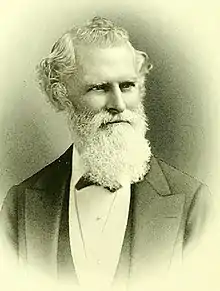George Washington Rains
George Washington Rains (1817 – March 21, 1898) was a United States Army and later Confederate States Army officer. A skilled engineer and inventor; he was instrumental in providing the Confederacy with much-needed gunpowder throughout the American Civil War. He also was the younger brother of fellow Confederate general Gabriel J. Rains.
George Washington Rains | |
|---|---|
 George W. Rains during the Civil War | |
| Nickname(s) | Chief Chemist of the Confederacy |
| Born | 1817 Craven County, North Carolina |
| Died | March 21, 1898 Newburgh, New York |
| Buried | Saint George's Cemetery, Newburgh |
| Allegiance | United States of America Confederate States of America |
| Service/ | |
| Years of service | 1842–1856 1861–1865 |
| Rank | Brigadier General (not confirmed) |
| Unit | 4th U.S. Artillery Bureau of Nitre and Mining |
| Commands held | Augusta Powderworks 1st Regiment, Georgia Local Defense |
| Battles/wars |
|
| Relations | Brig. Gen. Gabriel J. Rains (brother) |
| Other work | College professor, author, inventor |

Biography
Rains was born in Craven County in North Carolina in 1817. He graduated from the United States Military Academy at West Point in 1842 as third out of a class of 56; being commissioned a 2nd Lieutenant in the Corps of Engineers. In the next year he transferred to the 4th U.S. Artillery Regiment and then became an assistant professor of chemistry, mineralogy, and geology back at West Point. He participated in the Mexican–American War, fighting at Vera Cruz, Cerro Gordo, Contreras, Churubusco, Molino del Rey and Chapultepec. For his services he was promoted to 1st Lieutenant and brevetted Captain. Over the next years he frequently changed stations and often served on recruiting duty. The full Captain's promotion came in February 1856 when he was stationed in New York but he resigned his commission half a year later.[1][2][3]
Rains became a proprietor of the Washington & Highland Iron Works in Newburgh, New York and became a patent holding engineer for steam engines and boilers.[2][4] He also married local Frances Josephine Ramsell (1838–1919) with whom he´d have a daughter, Fanny Powell Rains.
When the American Civil War began Rains joined the Confederate army. George Rains became a major in the Ordnance Department and was tasked to procure, and prospect for, gunpowder ingredients and to initiate the production. His work did much for the establishment of Gen. Isaac M. St. John's Bureau of Nitre and Mining, to which he transferred, in 1862. Being promoted to lieutenant colonel, he went to Augusta, Georgia and established the Confederate Powderworks at the Augusta Arsenal. Inspired by, and learning from, British material, his methods and inventions provided for comparably safe and efficient production. At its peak the powderworks regularly produced about 7,000 pounds (3,175 kg) a day, more than 2,750,000 pounds (1,247 tonnes) throughout the war, making it the second-largest gunpowder factory in the world at that time.[4][5] Rains was promoted to colonel on July 12, 1863. Rains also commanded the local defense regiment and led it during Sherman's March to the Sea.[2][3]
Shortly before the war ended he additionally received command of the ordnance depots and arsenals in the lower Confederacy. Apparently in 1865 he had been made a brigadier general in the Georgia Militia, too, though he also kept his Confederate rank.[2][3] His older brother Gabriel J. Rains was a West Point absolvent of 1827 and served as Confederate brigadier general as well. The older Rains had specialized in the creation and use of mines, booby traps and torpedoes; and headed the Torpedo Bureau.[6] Though not working together the brothers were collectively known as Bomb Brothers while George Rains on his own had been called the Chief Chemist of the Confederacy.[4]
After the war Rains stayed in Augusta and chose an academic life; he lectured as professor of chemistry at the Medical College of Georgia. Also becoming its dean, he retired in 1894 and returned to Newburgh.[4] He died there on March 21, 1898 and was buried at Saint George's Cemetery.[2]
Selected works by George W. Rains
- Rains, George W. (1845). Practical observations on the generation of statical electricity by the electrical machine. New Haven: B.L. Hamlen.
- Rains, George W. (1861). Notes on making saltpetre from the earth of the caves. New Orleans: Daily Delta job office.
- Rains, George W. (1882). History of the Confederate powder works. Newburgh, NY: Newburgh daily news print.
- US Patent No. 28.011 (Re-issue No. 1016); Improved Feed-Water Apparatus for Steam Boilers; 1860
- US Patent No. 32.204; Improvement in Steam-Boilers; 1861
- US Patent No. 32.532; Improved Safety Apparatus for Steam Boilers; 1861
See also
- List of American Civil War generals (Acting Confederate)
- Confederate Powderworks
- Bureau of Nitre and Mining
Notes
- Cullum, pp. 40-41
- Eicher, p. 444
- Aztec Club
- Robbins
- "Sibley Mill and Confederate Powder Works Chimney". National Park Service. National Park Service. Retrieved 25 March 2017.
- Eicher, p. 443
References
- Eicher, John H., and David J. Eicher, Civil War High Commands. Stanford: Stanford University Press, 2001. ISBN 978-0-8047-3641-1.
- Cullum, George W. (1868). Biographical Register of the Officers and Graduates of the United States Military Academy, Vol. 2 (2nd ed.). New York: D. Van Nostrand.
- Robbins, Peggy (April 2002). "The Confederacy's Bomb Brothers". Journal of Mine Action. 6 (1). Retrieved 25 March 2017.
- "George Washington Rains". Aztec Club. Retrieved 25 March 2017.
- Chip Bragg, Theodore P. Savas, et. al. Never For Want of Powder: The Confederate Powder Works at Augusta, Georgia. University of South Carolina Press, 2007. ISBN 978-1-570036-57-6.
External links
- George Washington Rains at Find a Grave
- Works by or about George Washington Rains in libraries (WorldCat catalog)
- Works by George Washington Rains at Project Gutenberg